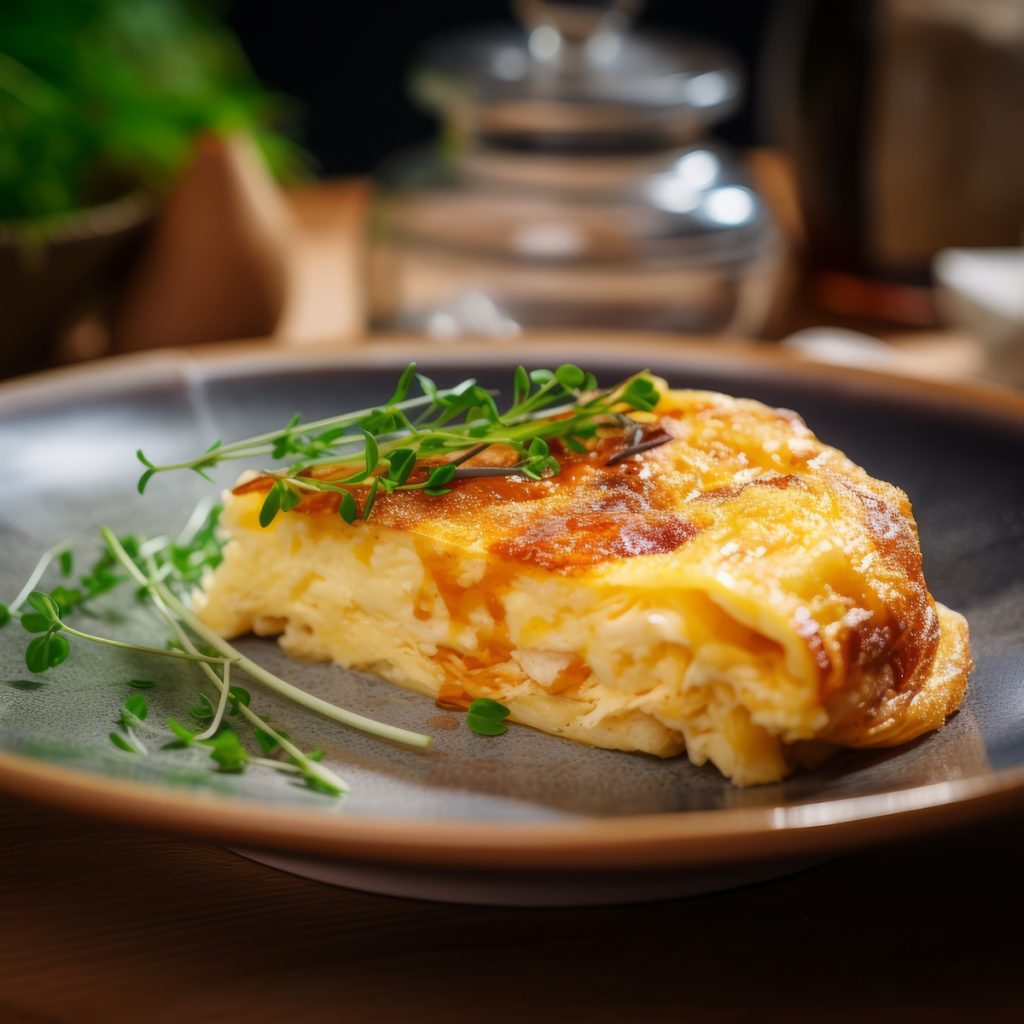Souffle Omelets
A souffle omelet is a light and fluffy variation of the traditional omelet. The key difference lies in the preparation method and the addition of beaten egg whites, which gives the omelet a soufflé-like texture.
The soufflé omelet and the regular omelet differ in texture and preparation method, resulting in distinct culinary experiences. Here’s a comparison:
Texture:
- Soufflé Omelette: The distinguishing feature of a soufflé omelet is its light and fluffy texture. This is achieved by incorporating beaten egg whites, which create air pockets in the omelet, making it airy and delicate.
- Regular Omelette: A traditional omelet is typically denser and more solid in texture. It is cooked by mixing beaten eggs with other ingredients and cooking them until the mixture is set.
Ingredients:
- Soufflé Omelet: Requires the separation of egg yolks and whites. The whites are beaten until stiff peaks form, contributing to the fluffiness of the omelet.
- Regular Omelet: Usually made by beating whole eggs and mixing them with various ingredients such as cheese, vegetables, and herbs.
Preparation Method:
- Soufflé Omelet: Involves a two-step process of beating egg whites separately and then folding them into the egg yolks. This method requires extra care to maintain the fluffiness of the egg whites.
- Regular Omelet: Prepared by beating whole eggs and cooking them in a pan with other ingredients. It’s a more straightforward and quicker process compared to the soufflé omelet.
Cooking Technique:
- Soufflé Omelet: Requires careful attention to prevent overmixing and deflating the beaten egg whites. It’s usually cooked on medium heat until set but still fluffy.
- Regular Omelet: Cooked over medium heat until the egg mixture is set. It is often folded or rolled during cooking.
Appearance:
- Soufflé Omelet: Has a voluminous and puffy appearance due to the incorporation of beaten egg whites. It may look more delicate and visually appealing.
- Regular Omelet: Has a flatter and more solid appearance. The focus is often on the ingredients mixed into the eggs.
Versatility:
- Soufflé Omelet: While versatile, the soufflé omelet is primarily known for its light and airy texture. It may be preferred for a more elegant or brunch-style presentation.
- Regular Omelette: Offers versatility in terms of ingredients and can be a quick and satisfying meal for any time of the day.
The soufflé omelet is a specialized version emphasizing a light and airy texture, making it distinct from the denser and more straightforward regular omelette. The choice between the two depends on personal preferences and the desired outcome for a particular meal.
How Do You Make a Souffle Omelet?
Separate the Eggs: Crack the eggs and separate the yolks from the whites. Place the yolks in one bowl and the whites in another.
Seasoning: Season the egg yolks with salt and pepper to taste. You can also add any other desired seasonings or ingredients at this stage.
Beat the Egg Whites: Beat the egg whites with a clean, dry beater or whisk until stiff peaks form. This will incorporate air into the egg whites and create a light, fluffy texture.
Combine Yolks and Whites: Gently fold the beaten egg whites into the seasoned egg yolks. Be careful not to deflate the egg whites too much; you want to maintain the lightness.
Cooking: Heat butter or oil in a non-stick skillet over medium heat. Pour the egg mixture into the skillet.
Optional Fillings: If desired, add any fillings such as cheese, herbs, vegetables, or ham to one-half of the omelet.
Fold and Serve: Once the omelet has set on the bottom but is still slightly runny on top, carefully fold it in half using a spatula. Cook for a little longer until it’s fully set but still light and fluffy.
Serve: Slide the soufflé omelet onto a plate and serve immediately. The result should be a delicate and airy omelet with a texture reminiscent of a soufflé.
Remember that the key to a successful soufflé omelet is gently handling the beaten egg whites to maintain their fluffiness. This type is often served for breakfast or brunch and can be customized with various fillings to suit your taste.
Simple Omelets
I am a big fan of simple omelets. My brother-in-law, Bill, makes the best one-egg omelets whenever we visit him at State College, PA. They are simple to prepare and delicious for breakfast or a light dinner.
Chef Robert Reynolds takes a simple omelet and “whips the life out of the eggs” and cooks it in the oven rather than on the stove and makes a “magical thing”. It is a cooking lesson demonstrating how easy it is to take your cooking to another level.
Update

Chef Robert Reynolds left us in 2012. He founded The Chef Studio in Portland and mentored many students in the U.S. and France for more than 30 years.
Prior to that, Reynolds owned and operated Le Trou, a restaurant in San Francisco, for 15 years. He passed away on Aug. 27 after a lengthy battle with lymphoma. He was 70 years old.
Souffle Omelet
Ingredients
- 1 cup cake crumbs or lady fingers
Rum Syrup
- ½ cup water
- ½ cup sugar and up to 1/4 cup dark Rum
- ¼ cup dark rum add the rum until you taste it
Prepare the Souffle
- 5 fresh eggs “preferably from chicken with names”
- ⅓ cup granulated sugar
- 3 tablespoon powdered sugar
- pinch salt
- 1 teaspoon vanilla extract
- 1 teaspoon orange flower water
- 1 tablespoon butter unsalted
Instructions
- Preheat the oven to 375° F.
- Moisten the cake or lady fingers with the rum syrup, enough to soften, but not soaked.
- Beat the eggs with the sugar, vanilla, orange flower water and a pinch of salt until they start to stiffen, about 1 minute.
- Add the powdered sugar and continue beating until they double in volume, and start to stiffen, about a minute more.
- Melt the butter in a 9-inch skillet over medium heat until it starts to foam without browning.
- Pour in the egg mixture. Cook for about 2 minutes until, when you slip a spatula under the omelet, you can see that it has started to develop golden color on the bottom.
- Put the skillet into the oven and let the omelet cook for another 3 or 4 minutes until the eggs have souffle and lightly firmed. The center should not be liquid.
- Remove from the oven and arrange the cake crumbs in a line across the omelet. Allow it to sit for a minute or two before carefully inverting and rolling it onto a plate.
- Add a garnish of seasonal berries, but don't be afraid to serve the omelet plain.
- Slice in 4 to 6 parts, dust with powdered sugar and serve.








